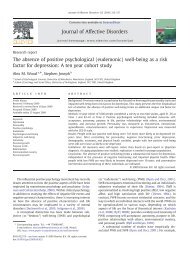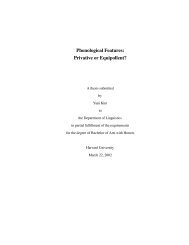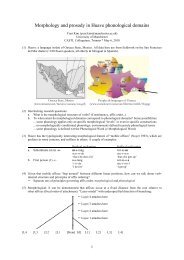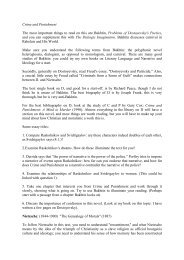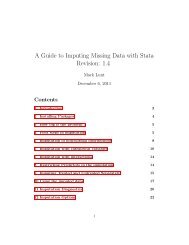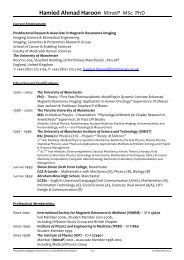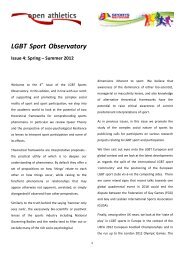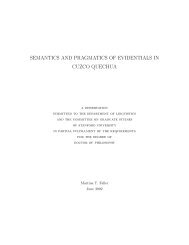You also want an ePaper? Increase the reach of your titles
YUMPU automatically turns print PDFs into web optimized ePapers that Google loves.
<strong>2.</strong> STRUCTURE OF A TURBULENT BOUNDARY LAYER SPRING 2009<br />
<strong>2.</strong>1 Shear stress and friction <strong>velocity</strong><br />
<strong>2.</strong>2 Length and <strong>velocity</strong> scales<br />
<strong>2.</strong>3 Inner layer<br />
<strong>2.</strong>4 Outer layer<br />
<strong>2.</strong>5 Overlap layer – the log law<br />
<strong>2.</strong>6 Viscous sublayer<br />
<strong>2.</strong>7 Limits of the various regions<br />
<strong>2.</strong>8 Velocity-defect layer: Coles’ Law of the Wake<br />
<strong>2.</strong>9 Effect of roughness<br />
Examples<br />
The analysis is applicable to a flat-plate boundary layer or fully-developed pipe or channel<br />
flow. First consider smooth walls.<br />
<strong>2.</strong>1 Shear Stress and Friction Velocity<br />
The shear stress (= rate of transport of momentum per unit area in the positive y direction) is<br />
∂U<br />
= − uv<br />
(1)<br />
∂y<br />
The viscous part varies from being the sole transporter of momentum at the wall to a<br />
negligible fraction of the total stress in the outer part of a turbulent boundary layer.<br />
For y < 0.1 , is approximately constant (why?) and equal to its value at the wall:<br />
≈<br />
w<br />
This is the constant-stress layer. As w has dimensions of [density] × [<strong>velocity</strong>] 2 2¡<br />
, it is possible<br />
to define an important <strong>velocity</strong> scale – the friction <strong>velocity</strong>, u – by<br />
w = u<br />
(2)<br />
or<br />
u ≡ /<br />
(3)<br />
<strong>2.</strong>2 Length and Velocity Scales<br />
Wall Units<br />
Very close to the wall the most important scaling parameters are:<br />
kinematic viscosity ;<br />
wall shear stress τw.<br />
¢ w<br />
¢ £ ¤ ¥ ¦ § ¨ The characteristic <strong>velocity</strong> and length scales are:<br />
friction <strong>velocity</strong>:<br />
viscous length scale:<br />
u ≡ w/<br />
≡<br />
u<br />
uτ<br />
(4)<br />
=<br />
(5) u<br />
Turbulent Boundary Layers 2 - 1 David Apsley<br />
y<br />
Ue<br />
U(y)<br />
δ
From these we can form non-dimensional <strong>velocity</strong> and height in wall units:<br />
+ U<br />
+ y u y<br />
U ≡ , y ≡ =<br />
u ¡ £<br />
y + is a sort of local Reynolds number. Its value is a measure of the relative importance of<br />
viscous and turbulent transport at different distances from the wall.<br />
Boundary-Layer Units<br />
At large y + the direct effect of viscosity on momentum transport is small and heights can be<br />
specified as a fraction of the boundary-layer depth :<br />
y<br />
= (7)<br />
The quantity<br />
u<br />
Re ≡ ¢ ¢<br />
=<br />
+<br />
is called the friction Reynolds number and is a global parameter of the boundary layer.<br />
Since fully-developed boundary-layer flow is completely specified by U, y, , , and u ,<br />
dimensional analysis (6 variables, 3 independent dimensions) yields a functional relationship<br />
between 6 – 3 = 3 dimensionless groups, conveniently taken as<br />
U y y<br />
= f , )<br />
u<br />
i.e.<br />
+ +<br />
U = f ( y , )<br />
(9) ¢ (£<br />
Almost all boundary-layer analysis is based upon the smooth overlap of the limiting cases –<br />
inner layer ( 0) and outer layer (y + » 1).<br />
<strong>2.</strong>3 Inner Layer (Prandtl, 1925)<br />
Dimensional parameters U, y, w, , – but not .<br />
dimensionless groups, conveniently taken as ¡<br />
Dimensional analysis (5 parameters, 3 independent dimensions) ⇒ 2 independent<br />
+<br />
U<br />
+<br />
= U / u and y = u¡y<br />
/ .<br />
Then we have the law of the wall:<br />
+ +<br />
U = f w ( y )<br />
(10)<br />
fw is expected to be a universal function; i.e. independent of the external flow.<br />
According to Pope (2000), the inner layer corresponds roughly to y / < 0.1, or the region<br />
over which the shear stress is approximately constant.<br />
Turbulent Boundary Layers 2 - 2 David Apsley<br />
(6)<br />
(8)
<strong>2.</strong>4 Outer Layer (Von Kármán, 1930)<br />
Dimensional parameters U, y, w, , – but not .<br />
Dimensional analysis (5 parameters, 3 independent dimensions) ⇒ 2 independent<br />
dimensionless groups, conveniently taken as<br />
U e −U<br />
y<br />
,<br />
=<br />
u<br />
Then one has the <strong>velocity</strong>-defect law:<br />
U e −U<br />
= f o ( )<br />
(11)<br />
u<br />
Unlike fw which is expected to be universal, fo( ) will vary with the particular flow.<br />
¢<br />
<strong>2.</strong>5 Overlap Layer – the Log Law<br />
As noted by C.B. Millikan (1937) the inner and outer layers can only overlap smoothly if the<br />
overlap-region <strong>velocity</strong> profile is logarithmic.<br />
Outer layer: U − U = f ( )<br />
+ +<br />
e o<br />
Inner layer:<br />
+ +<br />
U = f w ( y )<br />
Introducing + = u / , so that y + =<br />
+<br />
U (<br />
+<br />
) f ( ) + f (<br />
+<br />
)<br />
e<br />
= o w<br />
+ , and adding:<br />
+ to be the sum of separate functions of and + , fw must<br />
For a function fw of the product<br />
be logarithmic. This can be proved formally by differentiating successively with respect to<br />
each variable, as follows.<br />
Differentiate wrt + :<br />
U<br />
′<br />
(<br />
+<br />
) = 0 +<br />
+ ′<br />
e<br />
f w<br />
Differentiate wrt η:<br />
0 = f ′ (<br />
w<br />
+<br />
) +<br />
(<br />
+<br />
)<br />
f ′<br />
(<br />
+<br />
w<br />
+<br />
w<br />
+<br />
)<br />
+ +<br />
= f ′ ( ) ′′<br />
w y + y f ( y<br />
d + df<br />
w<br />
= ( y )<br />
+<br />
+<br />
dy<br />
dy<br />
)<br />
Hence,<br />
+ df<br />
w<br />
y +<br />
dy<br />
= constant<br />
This constant is conventionally written as 1/ , where (≈ 0.41), is von Kármán’s constant.<br />
+ + = df<br />
w<br />
dy<br />
1<br />
y<br />
which integrates to give<br />
1 +<br />
= ln y + B , B another constant.<br />
f w<br />
Turbulent Boundary Layers 2 - 3 David Apsley
Hence we have the log-law <strong>velocity</strong> profile:<br />
+ 1 +<br />
U = ln y + B<br />
or, equivalently,<br />
+ 1<br />
U = ln Ey<br />
+<br />
Notes.<br />
(1) There is some variation between sources, but typical values of the constants are<br />
= 0.41 (1/ = <strong>2.</strong>44) and B = 5.0 (E = 7.76).<br />
(2) Except in strong adverse pressure gradients (e.g. in a diffuser) the logarithmic <strong>velocity</strong><br />
profile is a good approximation across much of the shear layer. This observation turns<br />
out to extremely useful in deriving friction formulae – see Section 3.<br />
(3) In the log law region,<br />
+<br />
∂U<br />
u<br />
y ∂U<br />
+ ∂U<br />
= or = y = constant<br />
+<br />
∂y<br />
y<br />
u ∂y<br />
∂y<br />
This is often used as an alternative starting point for the derivation of the log law. ¢ ¢<br />
<strong>2.</strong>6 Viscous Sublayer<br />
Very close to the wall, turbulent fluctuations are damped out and the wall shear stress is<br />
almost entirely viscous:<br />
∂U<br />
= w , constant<br />
∂y<br />
which yields a linear <strong>velocity</strong> profile:<br />
Setting<br />
U<br />
w<br />
=<br />
w<br />
y<br />
= and rearranging,<br />
u 2¡<br />
+ +<br />
U = y<br />
(14)<br />
Experiment shows that the linear viscous sublayer corresponds roughly to y + < 5.<br />
<strong>2.</strong>7 Limits of the Various Regions<br />
Pope (2000) gives the following rough delimiting y + and y/ values.<br />
Inner layer (roughly y/ < 0.1) – <strong>velocity</strong> scales on u and y + , but not on .<br />
Outer layer (roughly y + > 50) – the direct effect of viscosity is negligible.<br />
Overlap region - exists at sufficiently high Reynolds number.<br />
In the overlap region the mean-<strong>velocity</strong> profile must be logarithmic. In fact the log law is a<br />
good approximation beyond the overlap region. Pope suggests:<br />
Turbulent Boundary Layers 2 - 4 David Apsley<br />
(12)<br />
(13)
Viscous sublayer: y + < 5 – linear <strong>velocity</strong> profile<br />
Buffer layer: 5 < y + < 30<br />
Log law region: y + > 30, y/ < 0.3 – logarithmic <strong>velocity</strong> profile<br />
<strong>2.</strong>8 Velocity-Defect Layer: Coles’ Law of the Wake<br />
In the outer layer the <strong>velocity</strong> profile deviates slightly from the log law, particularly in nonequilibrium<br />
boundary layers with a pressure gradient. Coles (1956) noted that the deviation or<br />
excess <strong>velocity</strong> above the log law had a wake-like shape relative to the free stream; i.e.<br />
y<br />
U = U + U f ( )<br />
log law<br />
where f is some S-shaped function with f(0) = 0, f(1) = 1; popular forms are<br />
f (<br />
2<br />
) = sin<br />
2<br />
f ( ) = 3<br />
2<br />
− 2<br />
3<br />
Then we have the Coles Law of the Wake:<br />
U<br />
u<br />
1 +<br />
= ln y<br />
2<br />
+ B + f ( y/<br />
)<br />
where the deviation from the log law is quantified by the Coles wake parameter .<br />
Typical values are:<br />
pipe flow or channel flow: = 0<br />
zero-pressure-gradient flat-plate boundary layer: = 0.45<br />
In general, is a function of pressure gradient.<br />
<strong>2.</strong>9 Effect of Roughness<br />
The seminal experimental work was done by Prandtl’s PhD student Johann Nikuradse, who<br />
measured the friction factor in pipes artificially roughened with densely-packed sand grains<br />
of size ks. The relative roughness ks/D varied from 1/30 to 1/1000.<br />
+<br />
The influence of wall roughness is characterised by k = u k /<br />
+<br />
Hydraulically Smooth: ( k s < 5 ; i.e. less than the viscous sublayer depth)<br />
In this regime roughness has no effect on the friction factor or mean-<strong>velocity</strong> profile.<br />
+<br />
Fully Rough: ( k s > 70 )<br />
Transfer of momentum to the wall is predominantly by pressure drag on roughness elements,<br />
not viscous stresses, and wall friction becomes essentially independent of Reynolds number<br />
for sufficiently large Re. Dimensional analysis implies<br />
+ 1 y<br />
U = ln + Bk<br />
k<br />
From experimental data, Bk ≈ 8.5.<br />
s<br />
Turbulent Boundary Layers 2 - 5 David Apsley<br />
s<br />
¡s<br />
.<br />
(15)
Transitional Roughness ( 5 < < 70<br />
+<br />
k s )<br />
Both roughness and viscous effects operate.<br />
+<br />
(These k s limits are those of Schlichting. White gives 4 and 60 instead, whilst Cebeci and<br />
Bradshaw’s transition formula below uses <strong>2.</strong>25 and 90.)<br />
An all-encompassing mean-<strong>velocity</strong> profile may be written<br />
+ 1 +<br />
ln<br />
~ +<br />
+ ( ) k B y U<br />
where<br />
~<br />
B<br />
= s<br />
⎧B<br />
⎪<br />
⎨<br />
⎪⎩<br />
B<br />
( k<br />
→<br />
k<br />
1 +<br />
− ln k s<br />
+<br />
s<br />
+<br />
( k s<br />
Suitable interpolation formulae are:<br />
Cebeci and Bradshaw (1977):<br />
→<br />
~ 1 +<br />
B ( 1−<br />
) B + ( B − ln k ) ,<br />
= k<br />
s<br />
Apsley (2007):<br />
~ 1<br />
= B − ln( k<br />
+<br />
B k<br />
s<br />
+ C)<br />
,<br />
0;<br />
hydraulically<br />
smooth)<br />
→ ∞;<br />
fully rough)<br />
⎧ 0 ,<br />
⎪<br />
+<br />
⎪ ⎡ ln( k ⎤<br />
s / <strong>2.</strong><br />
25)<br />
= ⎨ sin⎢<br />
⎥ ,<br />
⎪ ⎣ 2 ln( 90 / <strong>2.</strong><br />
25)<br />
⎦<br />
⎪⎩<br />
1 ,<br />
C = e<br />
( Bk −B<br />
)<br />
> 90<br />
< 90<br />
Turbulent Boundary Layers 2 - 6 David Apsley<br />
k<br />
+<br />
s<br />
+<br />
s<br />
<<br />
<strong>2.</strong><br />
25<br />
k<br />
<strong>2.</strong><br />
25<br />
(Both authors used slightly different values of B and Bk from those used in these Notes).<br />
In practice, we are often more interested in the resulting friction law (see Section 3). For pipe<br />
flow this is the Colebrook-White formula. The effect of surface roughness depends on its<br />
form as well as its size. The work of Colebrook (1939) and Moody (1944) helped to define<br />
“equivalent sand roughness” for many commercial pipe materials.<br />
Geophysical Flows<br />
Perhaps the ultimate in rough-wall boundary layers is the atmospheric boundary layer. In this<br />
case the mean <strong>velocity</strong> profile is typically written (with the meteorological convention of z<br />
for a vertical coordinate):<br />
u z<br />
U = ln( )<br />
(16)<br />
z0<br />
z0 is called the roughness length and comparison with the above formulae, fitting all<br />
constants inside the natural logarithm and taking Bk = 8.5, gives z0 ≈ k s / 30 . For typical rural<br />
conditions z0 has a value of about 0.1 m.<br />
¡<br />
< k<br />
+<br />
s
Examples<br />
Question 1.<br />
Consider airflow at 10 m s –1 over a flat plate. If the friction Reynolds number is 1200,<br />
calculate (a) the friction <strong>velocity</strong>; (b) the wall shear stress; (c) the depth of the boundary<br />
layer. Assume a Coles wake parameter = 0.45.<br />
Question <strong>2.</strong><br />
Wind velocities over open fields were measured as 5.89 m s –1 and 8.83 m s –1 at heights of<br />
2 m and 10 m respectively. Use this data to estimate: (a) the roughness length z0; (b) the<br />
friction <strong>velocity</strong> u ; (c) the <strong>velocity</strong> at height 25 m; (d) the average <strong>velocity</strong> over a depth of<br />
25 m.<br />
Question 3. (From White, 1994)<br />
J. Laufer’s (1954) pipe-flow experiments gave the following data at ReD ≈ 5×10 5<br />
r/R 0.0 0.102 0.206 0.412 0.617 0.784 0.846 0.907 0.963<br />
U/U0 1.0 0.997 0.988 0.959 0.908 0.847 0.818 0.771 0.690<br />
where U0 is the centreline <strong>velocity</strong>. Find the best-fit power-law profile of the form<br />
U<br />
U 0<br />
y 1/<br />
n<br />
= ( )<br />
R<br />
where y = R – r is the distance from the wall.<br />
Answers<br />
(1) (a) u = 0.41 m s –1<br />
(b) w = 0.20 N m –2<br />
(c) = 44 mm<br />
(2) (a) z0 = 0.080 m<br />
(b) u = 0.75 m s –1<br />
(c) U(z = 25 m) = 10.5 m s –1<br />
(d) Uav = 8.7 m s –1<br />
(3) n = 9<br />
Turbulent Boundary Layers 2 - 7 David Apsley







